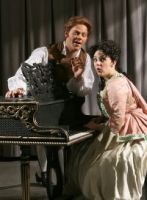
CCM's "Barber of Seville" Singing/Acting at its Best
Give yourself a valentine.

Attend Rossini’s “Barber of Seville” this weekend at the University of Cincinnati College-Conservatory of Music.
Everybody’s favorite comic opera opened in Patricia Corbett Theater Thursday evening and rarely have three hours sped by so quickly.
Director Karen Coe Miller, a CCM graduate student with impressive directing and performer-training experience, makes it show with this talented young cast, who wed singing and acting with uncommon vitality. Even Dr. Bartolo, crotchety guardian of the ripe young Rosina, straightened the papers on his desk in time to the music.
Music is what “Barber” is all about, and the CCM forces delivered handsomely on that score. As the cast took their bows before a standing, cheering audience, it was hard to tell who got the biggest ovation (repeats are sung by alternating casts). Exercising a firm hand in the pit and leading a noticeably lyrical Overture, was faculty conductor Annunziata Tomaro (it was both Miller and Tomaro’s CCM main stage debut).
The lovers Almaviva and Rosina were William Compton, a lyric tenor with a satiny tone and arresting high notes, and mezzo-soprano Brittany Wheeler, whose coloratura aria during Rosina’s singing lesson was the solo highpoint of the evening.
Singing Figaro was baritone R. Kenneth Stavert, a strapping, red-wigged wheeler-dealer who delivered perhaps the most famous aria in all opera (“Figaro, Figaro”) with full comedic swagger.
Scene-stealer was bass-baritone Paul Scholten as Dr. Bartolo. A fusty old crank re-conceived by Miller as a full blown obsessive-compulsive, he was brought vividly to life by Scholten, whose rapid “patter aria” facility was the most impressive of the show. Another favorite was bass Nathan Stark as Rosina’s music teacher Don Basilio, who, aided by a fake schnozzola of remarkable size, convulsed the audience whenever he ambled onstage. As Bartolo’s servant Berta, mezzo Melissa Radbill provided a welcome dose of reality.
Updated one century to 18th century Seville during Carnival -- a nice touch with so much of the opera having to do with disguises -- the plot revolves around Almaviva, a Spanish nobleman posing as a poor student, and Rosina, Bartolo’s closely guarded ward. Almaviva enlists the barber Figaro to help him free Rosina. Ruses include a drunken soldier seeking lodging in Bartolo’s house and a music teacher substituting for Basilio -- both Almaviva in disguise. Bartolo and Basilio almost foil their plan, but thanks to cunning and a little bribery, the lovers manage to get hitched before Bartolo can marry Rosina himself.
CCM’s Thomas Umfrid designed the period set, which consists of moveable units representing the street outside Bartolo’s house and its fastidiously-kept interior. One fast-paced scene follows another in Miller’s vivacious staging, with details matching Rossini’s masterpiece almost note-for-note. Highlights:
“La calunnia,” Basilio’s aria about scandal growing from a whisper to a roar, where Stark climbed to the top of the spiral staircase in Bartolo’s house, stage lights gradually rising, capped by “cannon” shots in the orchestra.
“A un dottor delle mia sorte,” where Bartolo mockingly (and futilely) scolds Rosina for lying to him.
The act one finale, where Bartolo and his household are struck dumb, then totally confused, when police, called to arrest the disorderly Almaviva, desist (he secretly informs the officer of his noble status).
“Pace e gioia,” Compton’s fawning greeting to Bartolo when Almaviva as the music teacher arrives for Rosina’s lesson.
The singing lesson, where Bartolo snoozes on and off during the lovers’ timed-to-match music-making and love-making, then demonstrates “real” singing himself in a castrato (falsetto) voice.
The final act trio where Stavert as Figaro tries to hurry the lovers’ rapturous duet.
The final shot of the evening said it all: a burst of multi-colored confetti from the wings after the knot was finally tied and love conquered all. Go see this one.
Sung in Italian with projected English captions, the opera repeats at 8 p.m. Friday, 2:30 and 8 p.m. Saturday and 2:30 p.m. in Patricia Corbett Theater. Tickets are $15-28 at (513) 556-4183 or www.ccm.uc.edu.
(first published in the Cincinnati Enquirer Feb. 14, 2009)